HLT54115 Diploma of Nursing: Assessment 1 Part B - Case Study Analysis
VerifiedAdded on 2023/01/05
|9
|2603
|21
Case Study
AI Summary
This document presents a case study analysis of a nursing care plan for a patient, Mr. McFarlane, focusing on the role of an Enrolled Nurse (EN). The assignment addresses a scenario where the EN responds to a critical situation, detailing nursing actions and rationales for decisions, considering the patient's vital signs (RR: 9, SpO2: 74%, BP: 100/60, HR: 45, Temp: 38.7, BGL 1.9 mmol/L, GCS 12), and medical history. The response includes discussions on patient positioning, referral protocols, and safety precautions. The document further explores updating the patient's plan of care, outlining new nursing diagnoses, interventions, multidisciplinary team involvement, and expected outcomes, aligning with the EN's scope of practice. Nursing documentation, including vital signs, potential diagnoses, safety concerns, and interventions, is also provided. The assignment concludes with a reflection on the NMBA Enrolled Nurse standards for practice, analyzing indicators related to accountability, information interpretation, and collaboration within the healthcare team.
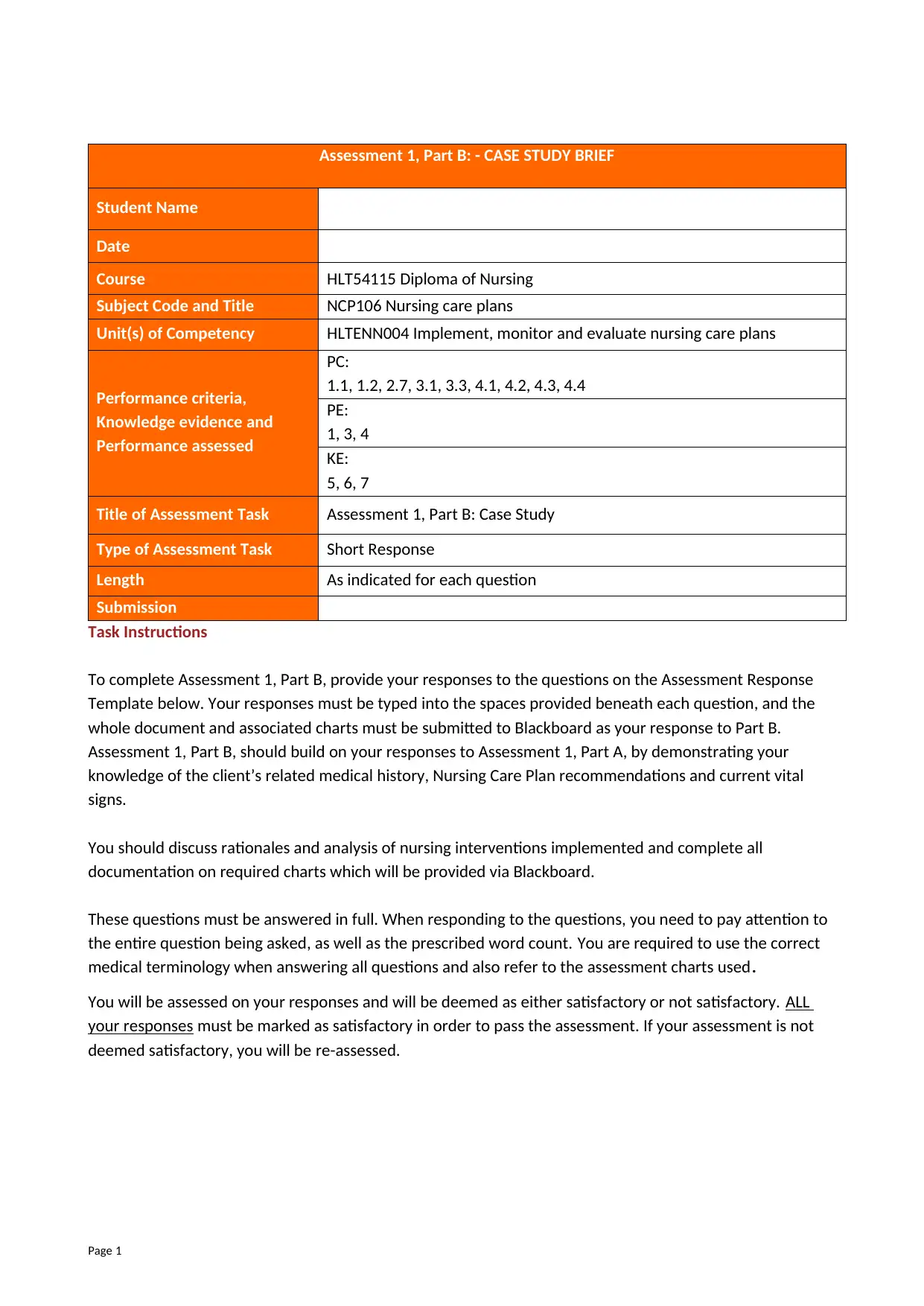
Assessment 1, Part B: - CASE STUDY BRIEF
Student Name
Date
Course HLT54115 Diploma of Nursing
Subject Code and Title NCP106 Nursing care plans
Unit(s) of Competency HLTENN004 Implement, monitor and evaluate nursing care plans
Performance criteria,
Knowledge evidence and
Performance assessed
PC:
1.1, 1.2, 2.7, 3.1, 3.3, 4.1, 4.2, 4.3, 4.4
PE:
1, 3, 4
KE:
5, 6, 7
Title of Assessment Task Assessment 1, Part B: Case Study
Type of Assessment Task Short Response
Length As indicated for each question
Submission
Task Instructions
To complete Assessment 1, Part B, provide your responses to the questions on the Assessment Response
Template below. Your responses must be typed into the spaces provided beneath each question, and the
whole document and associated charts must be submitted to Blackboard as your response to Part B.
Assessment 1, Part B, should build on your responses to Assessment 1, Part A, by demonstrating your
knowledge of the client’s related medical history, Nursing Care Plan recommendations and current vital
signs.
You should discuss rationales and analysis of nursing interventions implemented and complete all
documentation on required charts which will be provided via Blackboard.
These questions must be answered in full. When responding to the questions, you need to pay attention to
the entire question being asked, as well as the prescribed word count. You are required to use the correct
medical terminology when answering all questions and also refer to the assessment charts used.
You will be assessed on your responses and will be deemed as either satisfactory or not satisfactory. ALL
your responses must be marked as satisfactory in order to pass the assessment. If your assessment is not
deemed satisfactory, you will be re-assessed.
Page 1
Student Name
Date
Course HLT54115 Diploma of Nursing
Subject Code and Title NCP106 Nursing care plans
Unit(s) of Competency HLTENN004 Implement, monitor and evaluate nursing care plans
Performance criteria,
Knowledge evidence and
Performance assessed
PC:
1.1, 1.2, 2.7, 3.1, 3.3, 4.1, 4.2, 4.3, 4.4
PE:
1, 3, 4
KE:
5, 6, 7
Title of Assessment Task Assessment 1, Part B: Case Study
Type of Assessment Task Short Response
Length As indicated for each question
Submission
Task Instructions
To complete Assessment 1, Part B, provide your responses to the questions on the Assessment Response
Template below. Your responses must be typed into the spaces provided beneath each question, and the
whole document and associated charts must be submitted to Blackboard as your response to Part B.
Assessment 1, Part B, should build on your responses to Assessment 1, Part A, by demonstrating your
knowledge of the client’s related medical history, Nursing Care Plan recommendations and current vital
signs.
You should discuss rationales and analysis of nursing interventions implemented and complete all
documentation on required charts which will be provided via Blackboard.
These questions must be answered in full. When responding to the questions, you need to pay attention to
the entire question being asked, as well as the prescribed word count. You are required to use the correct
medical terminology when answering all questions and also refer to the assessment charts used.
You will be assessed on your responses and will be deemed as either satisfactory or not satisfactory. ALL
your responses must be marked as satisfactory in order to pass the assessment. If your assessment is not
deemed satisfactory, you will be re-assessed.
Page 1
Paraphrase This Document
Need a fresh take? Get an instant paraphrase of this document with our AI Paraphraser
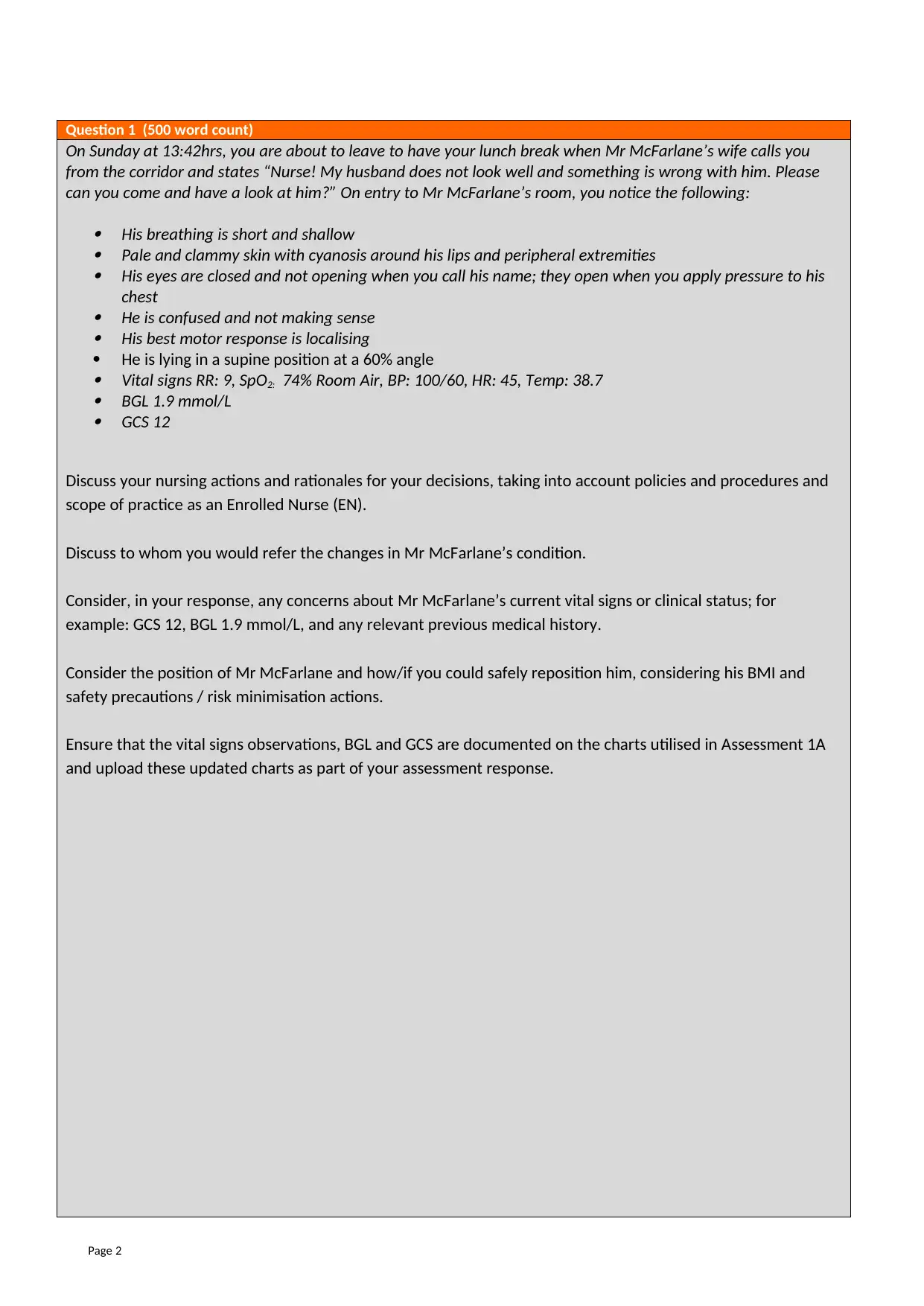
Question 1 (500 word count)
On Sunday at 13:42hrs, you are about to leave to have your lunch break when Mr McFarlane’s wife calls you
from the corridor and states “Nurse! My husband does not look well and something is wrong with him. Please
can you come and have a look at him?” On entry to Mr McFarlane’s room, you notice the following:
His breathing is short and shallow Pale and clammy skin with cyanosis around his lips and peripheral extremities His eyes are closed and not opening when you call his name; they open when you apply pressure to his
chest He is confused and not making sense His best motor response is localising
He is lying in a supine position at a 60% angle Vital signs RR: 9, SpO2: 74% Room Air, BP: 100/60, HR: 45, Temp: 38.7 BGL 1.9 mmol/L GCS 12
Discuss your nursing actions and rationales for your decisions, taking into account policies and procedures and
scope of practice as an Enrolled Nurse (EN).
Discuss to whom you would refer the changes in Mr McFarlane’s condition.
Consider, in your response, any concerns about Mr McFarlane’s current vital signs or clinical status; for
example: GCS 12, BGL 1.9 mmol/L, and any relevant previous medical history.
Consider the position of Mr McFarlane and how/if you could safely reposition him, considering his BMI and
safety precautions / risk minimisation actions.
Ensure that the vital signs observations, BGL and GCS are documented on the charts utilised in Assessment 1A
and upload these updated charts as part of your assessment response.
Page 2
On Sunday at 13:42hrs, you are about to leave to have your lunch break when Mr McFarlane’s wife calls you
from the corridor and states “Nurse! My husband does not look well and something is wrong with him. Please
can you come and have a look at him?” On entry to Mr McFarlane’s room, you notice the following:
His breathing is short and shallow Pale and clammy skin with cyanosis around his lips and peripheral extremities His eyes are closed and not opening when you call his name; they open when you apply pressure to his
chest He is confused and not making sense His best motor response is localising
He is lying in a supine position at a 60% angle Vital signs RR: 9, SpO2: 74% Room Air, BP: 100/60, HR: 45, Temp: 38.7 BGL 1.9 mmol/L GCS 12
Discuss your nursing actions and rationales for your decisions, taking into account policies and procedures and
scope of practice as an Enrolled Nurse (EN).
Discuss to whom you would refer the changes in Mr McFarlane’s condition.
Consider, in your response, any concerns about Mr McFarlane’s current vital signs or clinical status; for
example: GCS 12, BGL 1.9 mmol/L, and any relevant previous medical history.
Consider the position of Mr McFarlane and how/if you could safely reposition him, considering his BMI and
safety precautions / risk minimisation actions.
Ensure that the vital signs observations, BGL and GCS are documented on the charts utilised in Assessment 1A
and upload these updated charts as part of your assessment response.
Page 2
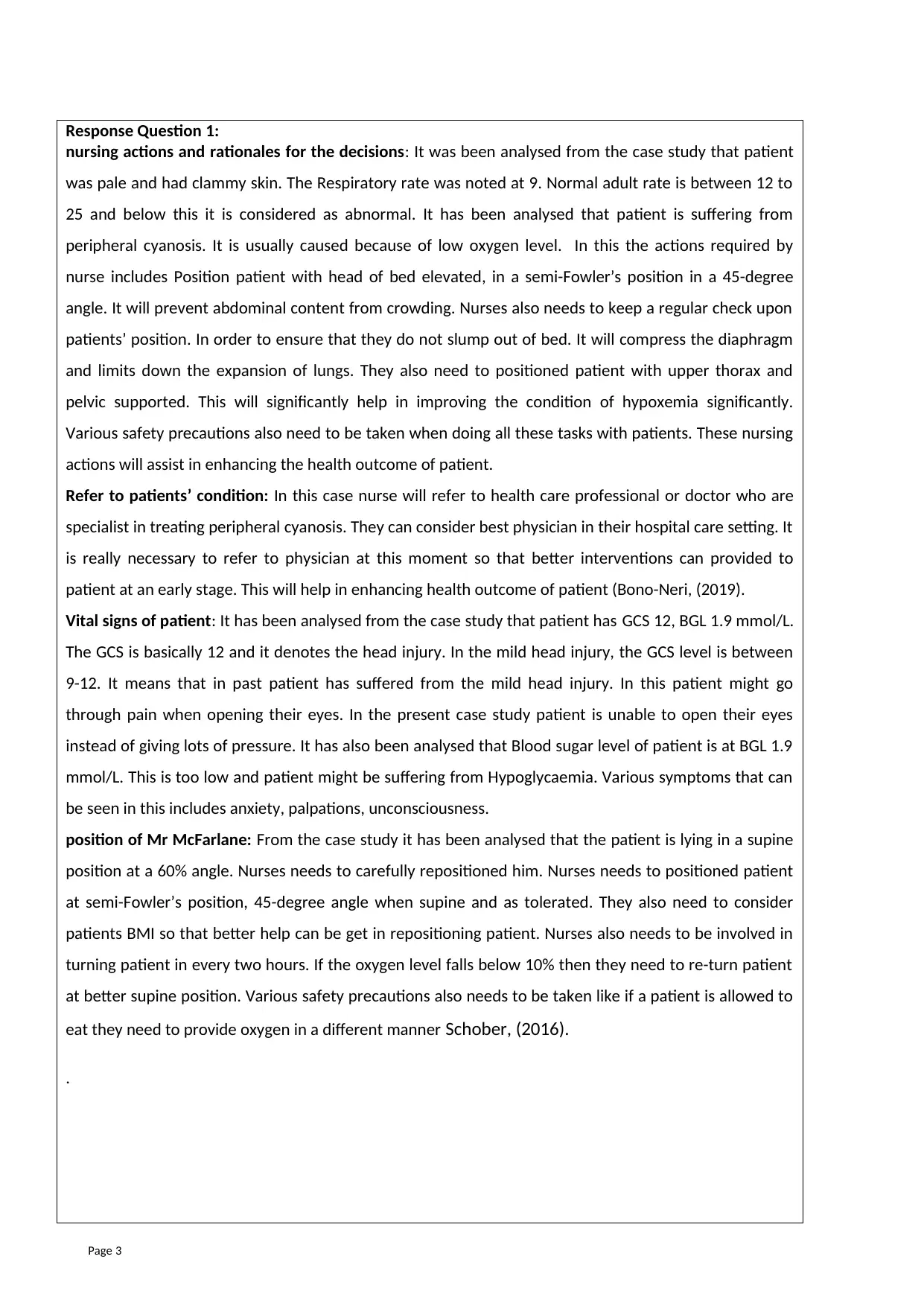
Response Question 1:
nursing actions and rationales for the decisions: It was been analysed from the case study that patient
was pale and had clammy skin. The Respiratory rate was noted at 9. Normal adult rate is between 12 to
25 and below this it is considered as abnormal. It has been analysed that patient is suffering from
peripheral cyanosis. It is usually caused because of low oxygen level. In this the actions required by
nurse includes Position patient with head of bed elevated, in a semi-Fowler’s position in a 45-degree
angle. It will prevent abdominal content from crowding. Nurses also needs to keep a regular check upon
patients’ position. In order to ensure that they do not slump out of bed. It will compress the diaphragm
and limits down the expansion of lungs. They also need to positioned patient with upper thorax and
pelvic supported. This will significantly help in improving the condition of hypoxemia significantly.
Various safety precautions also need to be taken when doing all these tasks with patients. These nursing
actions will assist in enhancing the health outcome of patient.
Refer to patients’ condition: In this case nurse will refer to health care professional or doctor who are
specialist in treating peripheral cyanosis. They can consider best physician in their hospital care setting. It
is really necessary to refer to physician at this moment so that better interventions can provided to
patient at an early stage. This will help in enhancing health outcome of patient (Bono-Neri, (2019).
Vital signs of patient: It has been analysed from the case study that patient has GCS 12, BGL 1.9 mmol/L.
The GCS is basically 12 and it denotes the head injury. In the mild head injury, the GCS level is between
9-12. It means that in past patient has suffered from the mild head injury. In this patient might go
through pain when opening their eyes. In the present case study patient is unable to open their eyes
instead of giving lots of pressure. It has also been analysed that Blood sugar level of patient is at BGL 1.9
mmol/L. This is too low and patient might be suffering from Hypoglycaemia. Various symptoms that can
be seen in this includes anxiety, palpations, unconsciousness.
position of Mr McFarlane: From the case study it has been analysed that the patient is lying in a supine
position at a 60% angle. Nurses needs to carefully repositioned him. Nurses needs to positioned patient
at semi-Fowler’s position, 45-degree angle when supine and as tolerated. They also need to consider
patients BMI so that better help can be get in repositioning patient. Nurses also needs to be involved in
turning patient in every two hours. If the oxygen level falls below 10% then they need to re-turn patient
at better supine position. Various safety precautions also needs to be taken like if a patient is allowed to
eat they need to provide oxygen in a different manner Schober, (2016).
.
Page 3
nursing actions and rationales for the decisions: It was been analysed from the case study that patient
was pale and had clammy skin. The Respiratory rate was noted at 9. Normal adult rate is between 12 to
25 and below this it is considered as abnormal. It has been analysed that patient is suffering from
peripheral cyanosis. It is usually caused because of low oxygen level. In this the actions required by
nurse includes Position patient with head of bed elevated, in a semi-Fowler’s position in a 45-degree
angle. It will prevent abdominal content from crowding. Nurses also needs to keep a regular check upon
patients’ position. In order to ensure that they do not slump out of bed. It will compress the diaphragm
and limits down the expansion of lungs. They also need to positioned patient with upper thorax and
pelvic supported. This will significantly help in improving the condition of hypoxemia significantly.
Various safety precautions also need to be taken when doing all these tasks with patients. These nursing
actions will assist in enhancing the health outcome of patient.
Refer to patients’ condition: In this case nurse will refer to health care professional or doctor who are
specialist in treating peripheral cyanosis. They can consider best physician in their hospital care setting. It
is really necessary to refer to physician at this moment so that better interventions can provided to
patient at an early stage. This will help in enhancing health outcome of patient (Bono-Neri, (2019).
Vital signs of patient: It has been analysed from the case study that patient has GCS 12, BGL 1.9 mmol/L.
The GCS is basically 12 and it denotes the head injury. In the mild head injury, the GCS level is between
9-12. It means that in past patient has suffered from the mild head injury. In this patient might go
through pain when opening their eyes. In the present case study patient is unable to open their eyes
instead of giving lots of pressure. It has also been analysed that Blood sugar level of patient is at BGL 1.9
mmol/L. This is too low and patient might be suffering from Hypoglycaemia. Various symptoms that can
be seen in this includes anxiety, palpations, unconsciousness.
position of Mr McFarlane: From the case study it has been analysed that the patient is lying in a supine
position at a 60% angle. Nurses needs to carefully repositioned him. Nurses needs to positioned patient
at semi-Fowler’s position, 45-degree angle when supine and as tolerated. They also need to consider
patients BMI so that better help can be get in repositioning patient. Nurses also needs to be involved in
turning patient in every two hours. If the oxygen level falls below 10% then they need to re-turn patient
at better supine position. Various safety precautions also needs to be taken like if a patient is allowed to
eat they need to provide oxygen in a different manner Schober, (2016).
.
Page 3
⊘ This is a preview!⊘
Do you want full access?
Subscribe today to unlock all pages.

Trusted by 1+ million students worldwide
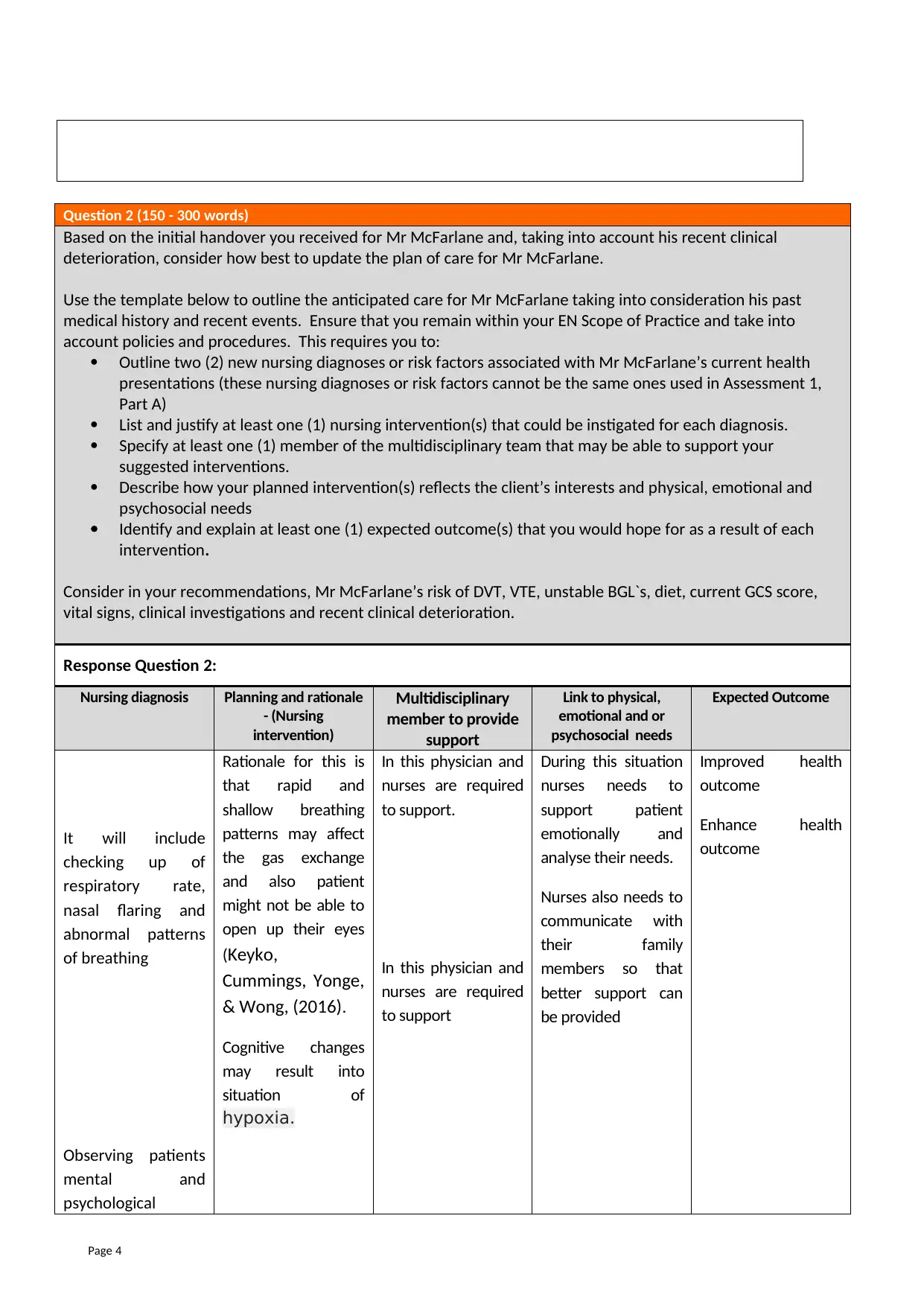
Question 2 (150 - 300 words)
Based on the initial handover you received for Mr McFarlane and, taking into account his recent clinical
deterioration, consider how best to update the plan of care for Mr McFarlane.
Use the template below to outline the anticipated care for Mr McFarlane taking into consideration his past
medical history and recent events. Ensure that you remain within your EN Scope of Practice and take into
account policies and procedures. This requires you to:
Outline two (2) new nursing diagnoses or risk factors associated with Mr McFarlane’s current health
presentations (these nursing diagnoses or risk factors cannot be the same ones used in Assessment 1,
Part A)
List and justify at least one (1) nursing intervention(s) that could be instigated for each diagnosis.
Specify at least one (1) member of the multidisciplinary team that may be able to support your
suggested interventions.
Describe how your planned intervention(s) reflects the client’s interests and physical, emotional and
psychosocial needs
Identify and explain at least one (1) expected outcome(s) that you would hope for as a result of each
intervention.
Consider in your recommendations, Mr McFarlane’s risk of DVT, VTE, unstable BGL`s, diet, current GCS score,
vital signs, clinical investigations and recent clinical deterioration.
Response Question 2:
Nursing diagnosis Planning and rationale
- (Nursing
intervention)
Multidisciplinary
member to provide
support
Link to physical,
emotional and or
psychosocial needs
Expected Outcome
It will include
checking up of
respiratory rate,
nasal flaring and
abnormal patterns
of breathing
Observing patients
mental and
psychological
Rationale for this is
that rapid and
shallow breathing
patterns may affect
the gas exchange
and also patient
might not be able to
open up their eyes
(Keyko,
Cummings, Yonge,
& Wong, (2016).
Cognitive changes
may result into
situation of
hypoxia.
In this physician and
nurses are required
to support.
In this physician and
nurses are required
to support
During this situation
nurses needs to
support patient
emotionally and
analyse their needs.
Nurses also needs to
communicate with
their family
members so that
better support can
be provided
Improved health
outcome
Enhance health
outcome
Page 4
Based on the initial handover you received for Mr McFarlane and, taking into account his recent clinical
deterioration, consider how best to update the plan of care for Mr McFarlane.
Use the template below to outline the anticipated care for Mr McFarlane taking into consideration his past
medical history and recent events. Ensure that you remain within your EN Scope of Practice and take into
account policies and procedures. This requires you to:
Outline two (2) new nursing diagnoses or risk factors associated with Mr McFarlane’s current health
presentations (these nursing diagnoses or risk factors cannot be the same ones used in Assessment 1,
Part A)
List and justify at least one (1) nursing intervention(s) that could be instigated for each diagnosis.
Specify at least one (1) member of the multidisciplinary team that may be able to support your
suggested interventions.
Describe how your planned intervention(s) reflects the client’s interests and physical, emotional and
psychosocial needs
Identify and explain at least one (1) expected outcome(s) that you would hope for as a result of each
intervention.
Consider in your recommendations, Mr McFarlane’s risk of DVT, VTE, unstable BGL`s, diet, current GCS score,
vital signs, clinical investigations and recent clinical deterioration.
Response Question 2:
Nursing diagnosis Planning and rationale
- (Nursing
intervention)
Multidisciplinary
member to provide
support
Link to physical,
emotional and or
psychosocial needs
Expected Outcome
It will include
checking up of
respiratory rate,
nasal flaring and
abnormal patterns
of breathing
Observing patients
mental and
psychological
Rationale for this is
that rapid and
shallow breathing
patterns may affect
the gas exchange
and also patient
might not be able to
open up their eyes
(Keyko,
Cummings, Yonge,
& Wong, (2016).
Cognitive changes
may result into
situation of
hypoxia.
In this physician and
nurses are required
to support.
In this physician and
nurses are required
to support
During this situation
nurses needs to
support patient
emotionally and
analyse their needs.
Nurses also needs to
communicate with
their family
members so that
better support can
be provided
Improved health
outcome
Enhance health
outcome
Page 4
Paraphrase This Document
Need a fresh take? Get an instant paraphrase of this document with our AI Paraphraser
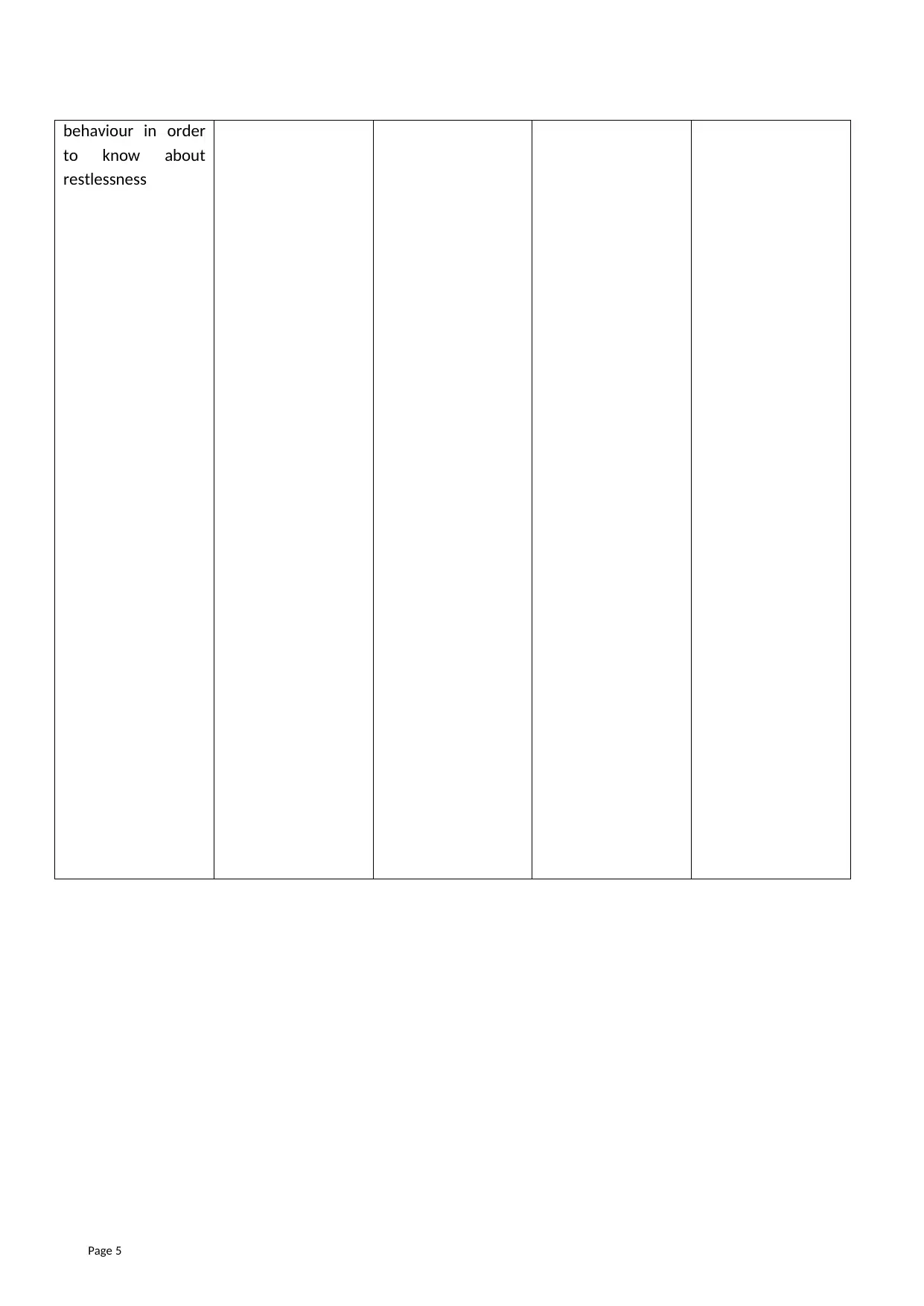
behaviour in order
to know about
restlessness
Page 5
to know about
restlessness
Page 5
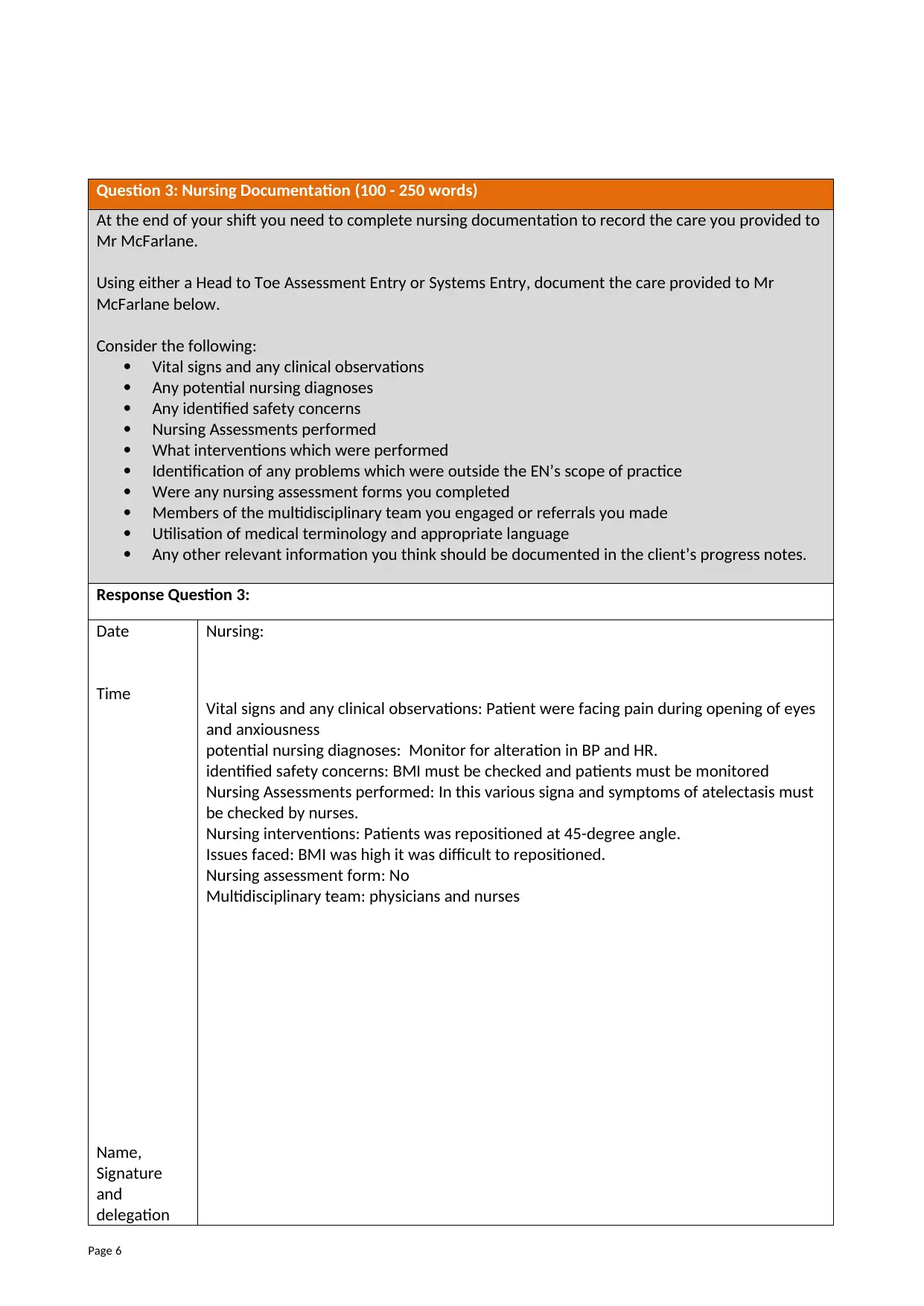
Question 3: Nursing Documentation (100 - 250 words)
At the end of your shift you need to complete nursing documentation to record the care you provided to
Mr McFarlane.
Using either a Head to Toe Assessment Entry or Systems Entry, document the care provided to Mr
McFarlane below.
Consider the following:
Vital signs and any clinical observations
Any potential nursing diagnoses
Any identified safety concerns
Nursing Assessments performed
What interventions which were performed
Identification of any problems which were outside the EN’s scope of practice
Were any nursing assessment forms you completed
Members of the multidisciplinary team you engaged or referrals you made
Utilisation of medical terminology and appropriate language
Any other relevant information you think should be documented in the client’s progress notes.
Response Question 3:
Date
Time
Name,
Signature
and
delegation
Nursing:
Vital signs and any clinical observations: Patient were facing pain during opening of eyes
and anxiousness
potential nursing diagnoses: Monitor for alteration in BP and HR.
identified safety concerns: BMI must be checked and patients must be monitored
Nursing Assessments performed: In this various signa and symptoms of atelectasis must
be checked by nurses.
Nursing interventions: Patients was repositioned at 45-degree angle.
Issues faced: BMI was high it was difficult to repositioned.
Nursing assessment form: No
Multidisciplinary team: physicians and nurses
Page 6
At the end of your shift you need to complete nursing documentation to record the care you provided to
Mr McFarlane.
Using either a Head to Toe Assessment Entry or Systems Entry, document the care provided to Mr
McFarlane below.
Consider the following:
Vital signs and any clinical observations
Any potential nursing diagnoses
Any identified safety concerns
Nursing Assessments performed
What interventions which were performed
Identification of any problems which were outside the EN’s scope of practice
Were any nursing assessment forms you completed
Members of the multidisciplinary team you engaged or referrals you made
Utilisation of medical terminology and appropriate language
Any other relevant information you think should be documented in the client’s progress notes.
Response Question 3:
Date
Time
Name,
Signature
and
delegation
Nursing:
Vital signs and any clinical observations: Patient were facing pain during opening of eyes
and anxiousness
potential nursing diagnoses: Monitor for alteration in BP and HR.
identified safety concerns: BMI must be checked and patients must be monitored
Nursing Assessments performed: In this various signa and symptoms of atelectasis must
be checked by nurses.
Nursing interventions: Patients was repositioned at 45-degree angle.
Issues faced: BMI was high it was difficult to repositioned.
Nursing assessment form: No
Multidisciplinary team: physicians and nurses
Page 6
⊘ This is a preview!⊘
Do you want full access?
Subscribe today to unlock all pages.

Trusted by 1+ million students worldwide
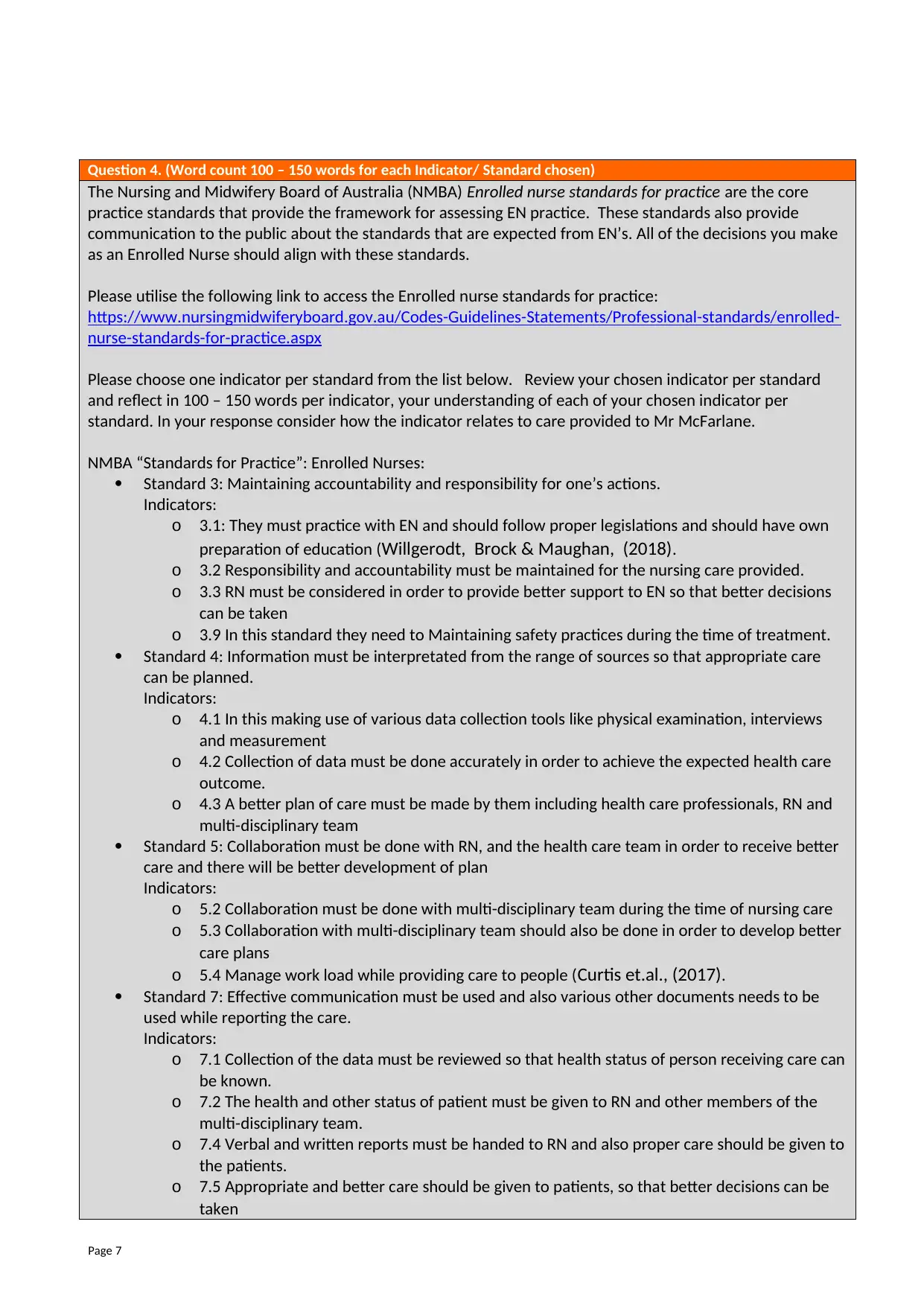
Question 4. (Word count 100 – 150 words for each Indicator/ Standard chosen)
The Nursing and Midwifery Board of Australia (NMBA) Enrolled nurse standards for practice are the core
practice standards that provide the framework for assessing EN practice. These standards also provide
communication to the public about the standards that are expected from EN’s. All of the decisions you make
as an Enrolled Nurse should align with these standards.
Please utilise the following link to access the Enrolled nurse standards for practice:
https://www.nursingmidwiferyboard.gov.au/Codes-Guidelines-Statements/Professional-standards/enrolled-
nurse-standards-for-practice.aspx
Please choose one indicator per standard from the list below. Review your chosen indicator per standard
and reflect in 100 – 150 words per indicator, your understanding of each of your chosen indicator per
standard. In your response consider how the indicator relates to care provided to Mr McFarlane.
NMBA “Standards for Practice”: Enrolled Nurses:
Standard 3: Maintaining accountability and responsibility for one’s actions.
Indicators:
o 3.1: They must practice with EN and should follow proper legislations and should have own
preparation of education (Willgerodt, Brock & Maughan, (2018).
o 3.2 Responsibility and accountability must be maintained for the nursing care provided.
o 3.3 RN must be considered in order to provide better support to EN so that better decisions
can be taken
o 3.9 In this standard they need to Maintaining safety practices during the time of treatment.
Standard 4: Information must be interpretated from the range of sources so that appropriate care
can be planned.
Indicators:
o 4.1 In this making use of various data collection tools like physical examination, interviews
and measurement
o 4.2 Collection of data must be done accurately in order to achieve the expected health care
outcome.
o 4.3 A better plan of care must be made by them including health care professionals, RN and
multi-disciplinary team
Standard 5: Collaboration must be done with RN, and the health care team in order to receive better
care and there will be better development of plan
Indicators:
o 5.2 Collaboration must be done with multi-disciplinary team during the time of nursing care
o 5.3 Collaboration with multi-disciplinary team should also be done in order to develop better
care plans
o 5.4 Manage work load while providing care to people (Curtis et.al., (2017).
Standard 7: Effective communication must be used and also various other documents needs to be
used while reporting the care.
Indicators:
o 7.1 Collection of the data must be reviewed so that health status of person receiving care can
be known.
o 7.2 The health and other status of patient must be given to RN and other members of the
multi-disciplinary team.
o 7.4 Verbal and written reports must be handed to RN and also proper care should be given to
the patients.
o 7.5 Appropriate and better care should be given to patients, so that better decisions can be
taken
Page 7
The Nursing and Midwifery Board of Australia (NMBA) Enrolled nurse standards for practice are the core
practice standards that provide the framework for assessing EN practice. These standards also provide
communication to the public about the standards that are expected from EN’s. All of the decisions you make
as an Enrolled Nurse should align with these standards.
Please utilise the following link to access the Enrolled nurse standards for practice:
https://www.nursingmidwiferyboard.gov.au/Codes-Guidelines-Statements/Professional-standards/enrolled-
nurse-standards-for-practice.aspx
Please choose one indicator per standard from the list below. Review your chosen indicator per standard
and reflect in 100 – 150 words per indicator, your understanding of each of your chosen indicator per
standard. In your response consider how the indicator relates to care provided to Mr McFarlane.
NMBA “Standards for Practice”: Enrolled Nurses:
Standard 3: Maintaining accountability and responsibility for one’s actions.
Indicators:
o 3.1: They must practice with EN and should follow proper legislations and should have own
preparation of education (Willgerodt, Brock & Maughan, (2018).
o 3.2 Responsibility and accountability must be maintained for the nursing care provided.
o 3.3 RN must be considered in order to provide better support to EN so that better decisions
can be taken
o 3.9 In this standard they need to Maintaining safety practices during the time of treatment.
Standard 4: Information must be interpretated from the range of sources so that appropriate care
can be planned.
Indicators:
o 4.1 In this making use of various data collection tools like physical examination, interviews
and measurement
o 4.2 Collection of data must be done accurately in order to achieve the expected health care
outcome.
o 4.3 A better plan of care must be made by them including health care professionals, RN and
multi-disciplinary team
Standard 5: Collaboration must be done with RN, and the health care team in order to receive better
care and there will be better development of plan
Indicators:
o 5.2 Collaboration must be done with multi-disciplinary team during the time of nursing care
o 5.3 Collaboration with multi-disciplinary team should also be done in order to develop better
care plans
o 5.4 Manage work load while providing care to people (Curtis et.al., (2017).
Standard 7: Effective communication must be used and also various other documents needs to be
used while reporting the care.
Indicators:
o 7.1 Collection of the data must be reviewed so that health status of person receiving care can
be known.
o 7.2 The health and other status of patient must be given to RN and other members of the
multi-disciplinary team.
o 7.4 Verbal and written reports must be handed to RN and also proper care should be given to
the patients.
o 7.5 Appropriate and better care should be given to patients, so that better decisions can be
taken
Page 7
Paraphrase This Document
Need a fresh take? Get an instant paraphrase of this document with our AI Paraphraser
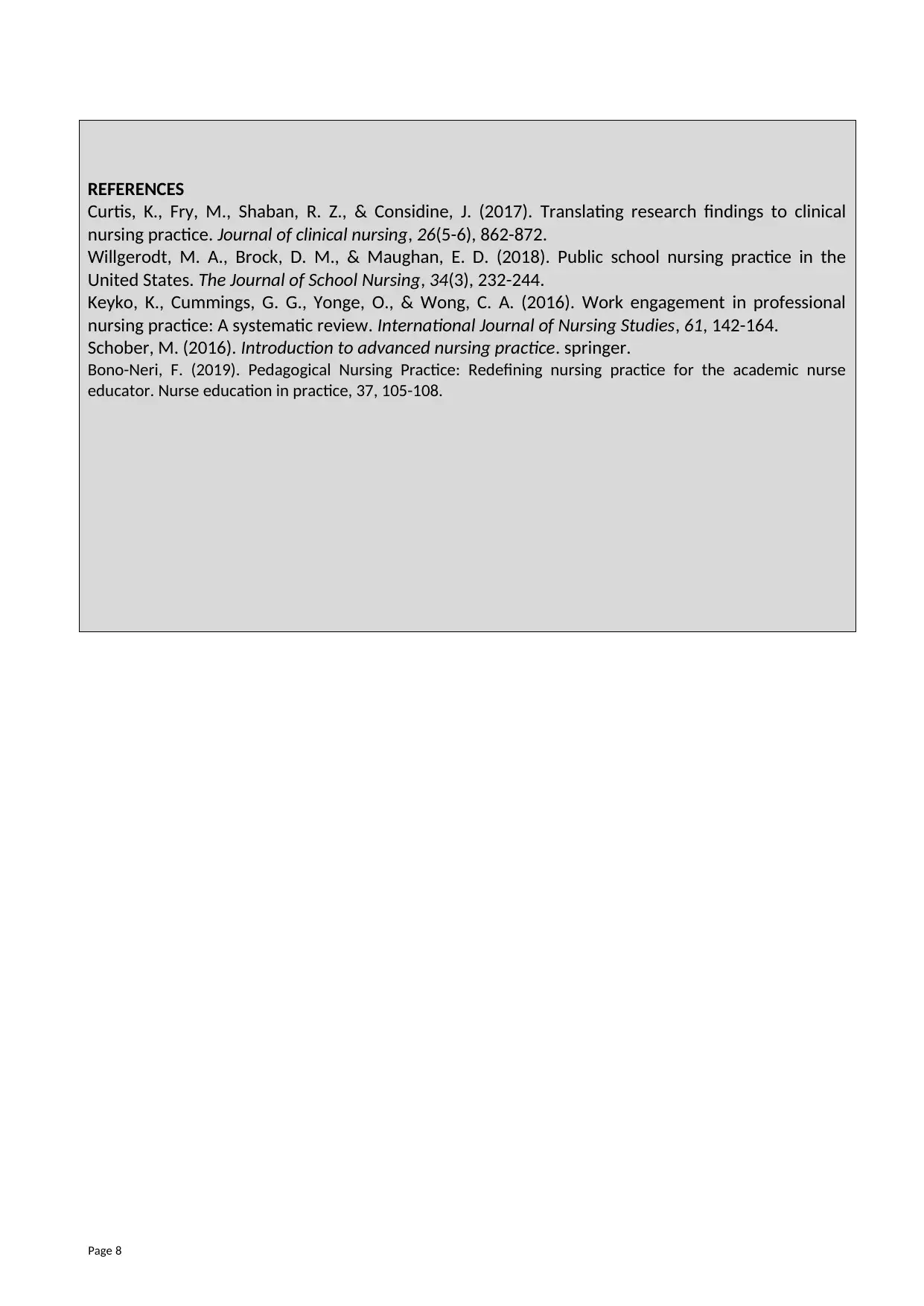
REFERENCES
Curtis, K., Fry, M., Shaban, R. Z., & Considine, J. (2017). Translating research findings to clinical
nursing practice. Journal of clinical nursing, 26(5-6), 862-872.
Willgerodt, M. A., Brock, D. M., & Maughan, E. D. (2018). Public school nursing practice in the
United States. The Journal of School Nursing, 34(3), 232-244.
Keyko, K., Cummings, G. G., Yonge, O., & Wong, C. A. (2016). Work engagement in professional
nursing practice: A systematic review. International Journal of Nursing Studies, 61, 142-164.
Schober, M. (2016). Introduction to advanced nursing practice. springer.
Bono-Neri, F. (2019). Pedagogical Nursing Practice: Redefining nursing practice for the academic nurse
educator. Nurse education in practice, 37, 105-108.
Page 8
Curtis, K., Fry, M., Shaban, R. Z., & Considine, J. (2017). Translating research findings to clinical
nursing practice. Journal of clinical nursing, 26(5-6), 862-872.
Willgerodt, M. A., Brock, D. M., & Maughan, E. D. (2018). Public school nursing practice in the
United States. The Journal of School Nursing, 34(3), 232-244.
Keyko, K., Cummings, G. G., Yonge, O., & Wong, C. A. (2016). Work engagement in professional
nursing practice: A systematic review. International Journal of Nursing Studies, 61, 142-164.
Schober, M. (2016). Introduction to advanced nursing practice. springer.
Bono-Neri, F. (2019). Pedagogical Nursing Practice: Redefining nursing practice for the academic nurse
educator. Nurse education in practice, 37, 105-108.
Page 8
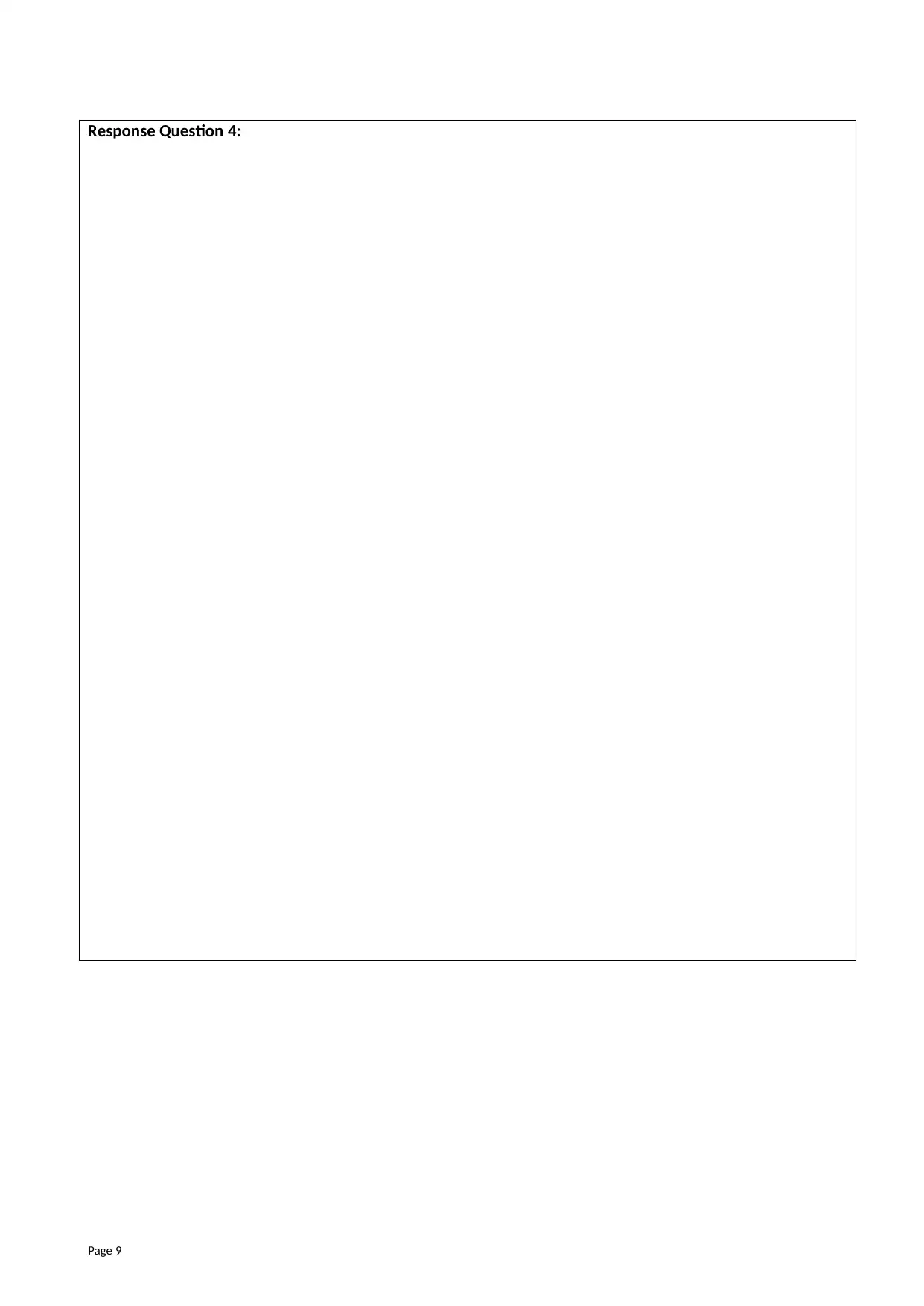
Response Question 4:
maxim maximum um maximum
Page 9
maxim maximum um maximum
Page 9
⊘ This is a preview!⊘
Do you want full access?
Subscribe today to unlock all pages.

Trusted by 1+ million students worldwide
1 out of 9
Related Documents
Your All-in-One AI-Powered Toolkit for Academic Success.
+13062052269
info@desklib.com
Available 24*7 on WhatsApp / Email
![[object Object]](/_next/static/media/star-bottom.7253800d.svg)
Unlock your academic potential
Copyright © 2020–2025 A2Z Services. All Rights Reserved. Developed and managed by ZUCOL.





